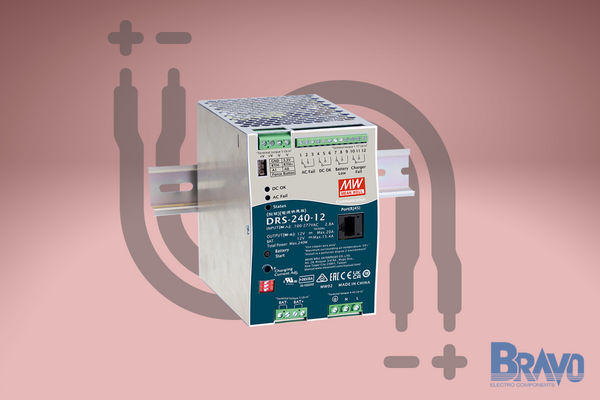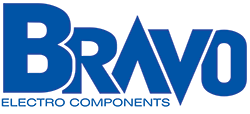
Whether you're replacing a faulty unit or installing one to a new system, installing a new DIN rail power supply can be complex and overwhelming. But it doesn't have to be this way - the experts at Bravo Electro are here to help.
Today, we'll teach you how to hookup DIN rail power supply units with a step-by-step guide. Despite the stress you may be feeling in regard to getting your DIN rail power supply hooked up, it's actually quite straightforward. Tools are rarely needed!
Today, we'll discuss this and other relevant information - like how to choose the best unit or troubleshoot your installation. As the most trusted source for all things AC DC power supplies, you can rest assured you'll find the specific DIN rail power supply you're looking for in our catalog.
And if you aren't sure where to start, just reach out - we're eager to assist you. We can even provide personalized help with installing your unit. But before we actually teach you how to install DIN rail power supplies, let's provide a brief overview of what these are used for.
What is a DIN Rail Power Supply Used for?
If you want a detailed overview of what a DIN rail power supply is, we have a complete guide detailing the topic. However, we'll summarize the basics of this type of unit below.
This unique type of power supply is used on metal DIN rails - as the name suggests. They can then provide stable, reliable power to whatever it is your business uses DIN rails for.
They provide a constant, safe flow of electricity to machinery or other electrical components - and are often found in industrial settings where they’re responsible for powering motors, lights, control systems, and more. But even homeowners may rely on these for putting up security cameras or other electronic devices that may not have a reliable power source nearby.
Regardless of what you use your DIN rail power supply for, you need one you can count on - so let's quickly discuss how to choose the right unit before getting into the installation side of things.
How to Choose the Right Unit for Your Needs
There are a few critical criteria to consider when searching for the right DIN rail power supply. If you're simply replacing a faulty unit, it's as simple as matching the specifications on that unit - at least, assuming that was the most optimal choice.
But if you're adding a new power supply to your DIN rail rather than replacing one, it can be difficult to know where to start. As with the question of what AC adapter you need or how to choose AC to DC converter, it's as simple as considering these factors:
- Voltage Requirements & Other Input Parameters: There are 12-volt DC power supplies, 24-volt DC power supplies, and even 48-volt DC power supplies. Consider what your voltage needs are first, and then factor in other parameters - such as 1-phase vs 3-phase capabilities. Finally, consider if you're going to connect the power supply in series or parallel.
- Consider Operating Conditions: This is where you need to consider your specific use case. How hot or cold will the climate get in which your power supply operates? Are there other rugged conditions that require the use of a more durable, coated DIN rail power supply - such as dirt, dust, rattling, or humidity?
- Make Sure it Fits: Obviously, the power supply needs to fit on the rail with other circuit breakers or power supplies - and it needs to fit within the cabinet your DIN rail is situated in. You want space between individual components for airflow, too. So, consider dimensions as well. You should also determine if a specific installation is required - or if you're free to hook up the unit vertically or horizontally. We'll touch on this later, but horizontal installation will impair airflow and could cause derating.
- Longevity & Efficiency: You want to deal with replacing and hooking up DIN rail power supplies as infrequently as possible. Thus, it's worth investing in one that costs more but has a longer lifespan. Similarly, it's worth paying more for a more efficient unit that costs less on your energy bill - these also generate less heat.
- Ratings & Approvals: Consider any necessary (or desired) ratings or approvals that speak to the safety & testing of your unit - such as class 2 vs class ii ratings or UL listed vs UL recognized power supply.
That's the bulk of what goes into choosing your DIN rail power supply - but there are other features you can look for as well. For example, a remote control allows for automation and superior monitoring. You can even find hot-swap plug connectors, IO-link ports, and more.
Looking for Help?
Remember - Bravo Electro is your one-stop shop for all things power supplies. That means you can count on us to carry the specific unit you need. We source from the most trusted manufacturers in the industry, such as MeanWell. And with experts on standby ready to assist you, you don’t have to play the guessing game - we’ll talk over your needs and make a suitable recommendation.
With all this in mind, you are ready to find your DIN rail power supply and proceed to the next step - learning how to hookup DIN rail power supply units.
How to Hookup DIN Rail Power Supply Units: Step-by-Step Guide
As we mentioned earlier, learning how to hookup DIN rail power supply units is actually much easier and faster than you may have previously thought. The process is usually tool-free and takes just a couple of minutes.
Of course, the specific brand and model you purchase will have its own unique instructions - and we recommend you adhere to those. And when in doubt, you can reach out to our staff about any products you've purchased through us for detailed assistance in installation.
However, we'll provide a general overview of how to install DIN rail power supplies below:
- First things first - turn off the main power supply. Anything over 90v AC can cause serious bodily harm or death. Once that's out of the way and you've taken any other necessary safety precautions, it's time to get started.
- If you're removing an old unit (in the case of replacement), you should first remove all connections. You can use a screwdriver to apply pressure in the slot at the bottom of the unit's clip. Putting downward pressure should pop that connection free and release the unit.
- If there are other power supplies on the DIN rail, make sure you mount the new one in a space that allows for plenty of breathing room on all sides. This prevents overheating, allowing for the greatest efficiency and longest lifespan.
- Getting your unit on the DIN rail is easy - the two should just click together. Hold the power supply at an angle, anchoring one side of the connection around the rail. Then, rotate the other end down to snap the other connection in place. If you hear the click, you know you're good to go. It's that easy!
- At this point, it's time to start making your connections. Start with the load, followed by the AC supply, followed by the protective earth connection. It's important to make sure all wires are secured in the terminal block. This prevents short circuits, not only protecting your equipment but also protecting you. For additional safety, input cables must be properly fused. Finally, a manually controlled disconnect switch should be used.
- If necessary, there is a DC voltage adjustment on the front panel of many units. This helps you optimize your output. Just be sure to disconnect the power before making adjustments - as this keeps you safe while protecting equipment, too.
- Always install and operate your system with a proper ground connection. This will keep you in compliance with EMC and safety standards while helping you get the most out of your unit. A three-prong outlet is required for proper grounding.
- Once everything is connected, you can go ahead and turn the main power back on.
Congratulations - you have successfully installed your DIN rail power supply! That wasn't so bad, was it? Now that your power is on, it's time to make sure the unit is working as intended.
Troubleshooting DIN Rail Power Supply Problems
Even when following all the proper steps, it's not uncommon to run into issues with your new setup. That's why it's important to know how to troubleshoot power supply problems that may arise.
First, always check for loose wires or terminals at the power supply itself - as this is a common issue if you've just installed a unit. It can be tricky sometimes, but if you follow the instructions above closely, this should never be an issue. If a lack of voltage output from the power supply is the issue, you may need to adjust the DC voltage on the front panel.
Next, make sure your device is receiving power from the proper AC supply - as well as that all connections are secure. Finally, make sure your ground connection is up to code - a three-prong outlet is required for safety and compliance with EMC standards. And if you’re struggling with RFI noise, just read our complete guide on how to stop the issue!
If none of these solutions fix the problem, then it may be time to call in a professional electrician or expert technician - depending on how comfortable you feel troubleshooting such an issue. We can assist to some degree at Bravo Electro, as we have electrical engineers on staff - don't hesitate to get in touch!
Final Thoughts on How to Install DIN Rail Power Supply
No matter how daunting it may seem at first, setting up DIN rail power supplies isn't all that hard when you know how to do it properly. With accurate information and step-by-step instructions, you can easily install the power supply of your choice and get everything up and running.
By following these guidelines on how to install DIN rail power supply units from Bravo Electro, you will be sure to have a safe and secure installation - one that is compliant with EMC standards as well as safety regulations. And remember - if for any reason you feel uncomfortable or need additional help, our expert support staff is always standing by to lend a hand! Thanks for choosing Bravo Electro!
Want to learn more about power supply? Check out our discussion on is house electric AC or DC, the difference between AC and DC power, or our complete guide on what is a modular power supply?










